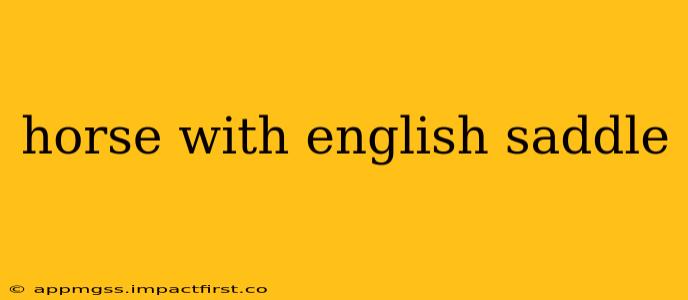The image of a horse with an English saddle evokes elegance, precision, and the thrill of equestrian sports. But what exactly constitutes an English saddle, and what makes it suitable for certain disciplines over others? This comprehensive guide will explore the world of English saddles, delving into their various types, features, and suitability for different riding styles.
What is an English Saddle?
An English saddle is a type of riding saddle characterized by its relatively flat seat, close contact with the horse, and a design that prioritizes rider balance and agility. Unlike Western saddles, which often feature a high cantle and pommel, English saddles are designed for a more forward-seated position, enabling greater control and precision, particularly in disciplines requiring nuanced movements. The key features that distinguish an English saddle include:
-
Deep or Shallow Seat: The depth of the seat varies depending on the saddle's intended discipline. Dressage saddles tend to have deeper seats, while jumping saddles might have shallower ones for greater freedom of movement.
-
Knee Rolls and Blocks: These provide support and help maintain the rider's position, particularly during jumping or turning. Their size and placement vary across different types of saddles.
-
Stirrup Bars: These are attached to the saddle's tree and support the stirrups, allowing the rider to maintain a secure and comfortable position.
-
Girth Straps: These straps secure the saddle to the horse. Their placement and the type of girth used can impact both comfort and security.
What are the Different Types of English Saddles?
The diverse world of equestrian sports requires specialized saddles tailored to specific disciplines. Here are some of the most common types:
1. Dressage Saddles:
Designed for dressage, these saddles prioritize close contact with the horse and a deep seat to aid the rider in maintaining a balanced and elegant posture. They often feature a more pronounced knee roll and a flatter panel to allow close contact and freedom of movement for the horse.
2. Jumping Saddles:
Jumping saddles are designed for jumping events, emphasizing rider security and freedom of movement. They typically have a shallower seat, a more forward-placed flap, and often incorporate knee blocks for added support during take-off and landing.
3. All-Purpose Saddles:
As the name suggests, all-purpose saddles are designed for versatility, suitable for a range of disciplines including flatwork, light jumping, and trail riding. They offer a balance between the features of dressage and jumping saddles, making them a popular choice for riders who participate in multiple disciplines or prefer a single saddle for various activities.
4. Eventing Saddles:
Eventing saddles are designed to meet the demands of eventing, a multi-phase equestrian competition involving dressage, cross-country, and show jumping. These saddles are often a compromise between dressage and jumping saddles, designed for comfort, security, and adaptability.
5. Racing Saddles:
These saddles are extremely lightweight and minimalist, designed for speed and efficiency in racing events. They prioritize minimal weight and a secure, aerodynamic position for the jockey.
How Do I Choose the Right English Saddle for My Horse and Me?
Selecting the appropriate English saddle involves careful consideration of several factors:
-
Rider's Experience and Discipline: Your riding experience and chosen discipline will heavily influence your saddle selection. Beginners might benefit from an all-purpose saddle, while experienced riders participating in specific disciplines require saddles tailored to those needs.
-
Horse's Build and Conformation: The saddle must fit your horse comfortably. An ill-fitting saddle can lead to discomfort, sores, and performance issues. A professional saddle fitter should evaluate both your horse and the saddle to ensure a proper fit.
-
Budget: English saddles range in price significantly, from affordable all-purpose models to high-end, custom-made saddles. Set a realistic budget before you begin your search.
-
Saddle Features: Consider the features crucial for your riding style. Deep vs. shallow seats, knee rolls, and blocks all play a significant role in comfort and rider performance.
What is the Difference Between an English Saddle and a Western Saddle?
The most significant difference lies in the riding style and the saddle's design. English saddles promote a forward-seated position with close contact to the horse, ideal for disciplines requiring precision and agility. Western saddles, conversely, feature a more upright, relaxed seat and are typically used for a range of activities, from trail riding to roping.
How Do I Take Care of My English Saddle?
Proper saddle care is crucial for maintaining its longevity and functionality. Regular cleaning with specialized saddle soap, conditioning leather to prevent cracking, and storing it in a cool, dry place are essential steps to prolong its lifespan.
This guide provides a comprehensive overview of English saddles. Remember that choosing the right saddle is a personalized process, and seeking professional advice from an experienced saddle fitter is crucial for both your comfort and your horse's well-being.
